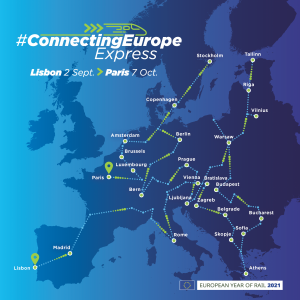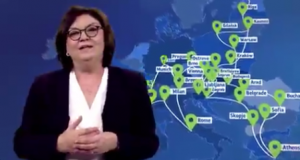 Connecting Europe Express train, part of the European Year of Rail initiatives, will cross 26 European countries in 36 days this autumn.
Connecting Europe Express train, part of the European Year of Rail initiatives, will cross 26 European countries in 36 days this autumn.
Community of European Railway and Infrastructure Companies (CER), which is organising the event, has announced the train route on the Europe Day. The Connecting Europe Express will begin its journey on 2 September in Lisbon and stopping in more than 40 cities in 26 countries, the train will link the Portuguese, Slovenian and French Presidencies of the Council of the EU, arriving in Paris on 7 October.
The train will travel on 20,000 km of rail lines, crossing 33 borders.
“Crisscrossing the continent, from Lisbon to Bucharest and from Berlin to Paris, the Connecting Europe Express will follow routes that bind us together – whether as countries, businesses or people. While a symbol for connectivity, this train also serves as a reminder that we still have a long way to go and much work to do before rail becomes the transport option of choice for Europeans. Welcome the Connecting Europe Express as it stops at a station near you and join the events taking place around the continent,” Commissioner for Transport Adina Vălean said.
 At each of the stops, events and other activities, adapted to local COVID-19 measures, will shine a light on the key role that rail plays for our society, but also on the challenges that rail must still overcome to attract more passengers and freight.
At each of the stops, events and other activities, adapted to local COVID-19 measures, will shine a light on the key role that rail plays for our society, but also on the challenges that rail must still overcome to attract more passengers and freight.
“Travelling through 26 European countries, the Connecting Europe Express is proof of the importance of the European Year of Rail. In order to achieve our climate targets, we need to further strengthen the vitality of rail with more international long-distance passenger rail services and we must also consistently shift freight transport to rail,” CER Chair Andreas Matthä said.
The lack of interoperability between some parts of Europe’s rail network will force the train to be formed in three different trains that fit the different gauges used in Europe. But it will also demonstrate the very good cooperation in place between railway undertakings and infrastructure managers. The train which will run on the standard gauge lines, will comprise six cars with two cars hosting mobile exhibitions on the many technologies and innovations already improving the rail experience, and on how the EU supports infrastructure projects. A conference, sitting, dining and sleeping coach will complete the train.
A separate train will run on the Iberian gauge in Portugal and Spain, and a third one on the Baltic gauge in Estonia, Latvia, and Lithuania. Both trains will meet with the standard gauge train along the route.
Five conferences have already been confirmed and will take place along the route in Lisbon, Bucharest, Brdo, Berlin, and Bettembourg, inviting discussion and debate on the ambitious targets and action plans for rail outlined in the EU’s Sustainable and Smart Mobility Strategy. The conferences will focus on EU infrastructure policy and highlight the role of the TEN-T in connecting not only Europe, but also transport.
The project is a unique endeavour, involving the CER, European rail operators, infrastructure managers and numerous other partners at EU and local level.
Share on:



